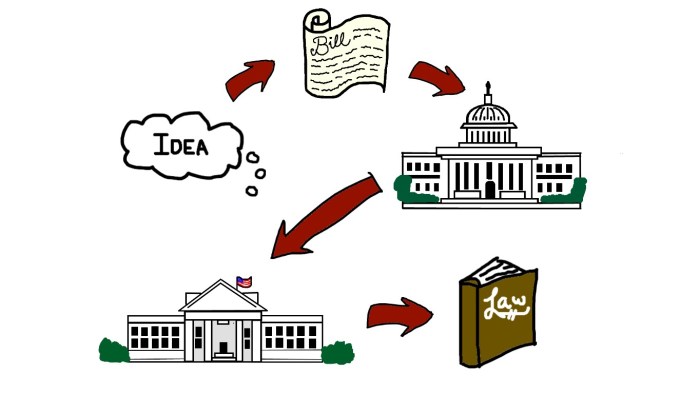Bill is to law as larva is to insect – a captivating analogy that unravels the intricate journey from a mere proposal to a binding legal force. Just as a larva undergoes a remarkable transformation to emerge as a fully developed insect, a bill undergoes a series of stages to attain the status of law.
In the legislative realm, a bill represents an idea or proposal that has the potential to become a law. It undergoes scrutiny, debate, and amendments before it can be passed by the legislature. Once passed, it proceeds to the executive branch for approval, where it can either be signed into law or vetoed.
Definition and Overview

In the context of the legislative process, a billis a proposed law that is introduced in a legislative body, such as a parliament or congress. It is typically drafted by a legislator or a group of legislators and undergoes a series of readings, debates, and amendments before it can be passed into law.
A law, on the other hand, is a set of rules or regulations that have been formally enacted by a legislative body and are legally binding upon the citizens or subjects of a state or country. Laws are typically created to regulate behavior, protect rights, and ensure order and justice in society.
Larva
In the life cycle of an insect, a larvais an immature form that hatches from an egg. Larvae typically have a different appearance and behavior from adult insects and undergo a process of metamorphosis to reach their adult form.
Relationship between Bill and Law: Bill Is To Law As Larva Is To

A bill is a proposed law that has not yet been enacted. It is introduced by a member of the legislature and must go through a series of steps before it can become a law. The process of a bill becoming a law is known as the legislative process.
The first step in the legislative process is the introduction of the bill. The bill is then assigned to a committee, which will review the bill and make recommendations for changes. The committee may hold hearings on the bill, where members of the public can testify about their support or opposition to the bill.
After the committee has completed its work, the bill is reported back to the full legislature.
The full legislature will then debate the bill and vote on it. If the bill passes, it will be sent to the governor for his or her signature. The governor can sign the bill into law, veto the bill, or allow the bill to become law without his or her signature.
Once a bill is signed into law, it becomes legally binding. The law will be enforced by the government, and anyone who violates the law may be subject to penalties.
Similarities and Differences between a Bill and a Law
A bill and a law are both pieces of legislation. However, there are some key differences between the two. A bill is a proposed law that has not yet been enacted, while a law is a law that has been enacted by the legislature and signed by the governor.
Another key difference between a bill and a law is that a bill can be amended, while a law cannot. A bill can be amended at any time before it is passed by the legislature. Once a bill is passed, it becomes a law and cannot be amended.
Relationship between Larva and Insect

Insects, a diverse and fascinating group of animals, undergo a process of metamorphosis during their life cycle. This involves a series of distinct stages, including the egg, larva, pupa, and adult stages. The larva stage plays a crucial role in the development and survival of the insect.During
the larva stage, the insect undergoes significant growth and changes in its physical form. Larvae are typically worm-like in appearance, with a soft body and no wings or legs. They feed voraciously, consuming large amounts of food to support their rapid growth.
The larva stage is also a time of hormonal changes, which trigger the development of adult characteristics during the pupal stage.
Much like how a bill transforms into a law, a larva undergoes metamorphosis to become an adult insect. Similarly, exploring the question “what does todals stand for” ( what does todals stand for ) reveals a process of transformation and discovery, where an abbreviation unfolds its meaning, just as a larva transforms into its adult form.
Role of the Larva
The larva stage is essential for the development and survival of the insect. It serves several important functions:
- Feeding and Growth:Larvae feed heavily, consuming large amounts of food to support their rapid growth and development.
- Energy Storage:Larvae often accumulate energy reserves in the form of fat or glycogen, which they utilize during the pupal stage and as adults.
- Hormonal Changes:The larva stage is characterized by hormonal changes that trigger the development of adult characteristics during the pupal stage.
- Protection:Larvae often possess protective adaptations, such as a tough exoskeleton or chemical defenses, to shield them from predators.
- Dispersal:Some larvae, particularly those of aquatic insects, have adaptations that allow them to disperse over long distances, increasing the chances of finding suitable habitats.
Comparison of Relationships

The relationship between a bill and a law shares similarities with the relationship between a larva and an insect. Both relationships involve a transformation process, where the initial form undergoes changes to reach a more developed or mature state.
Roles of External Factors
External factors play a crucial role in both relationships. For a bill to become a law, it must pass through various stages of the legislative process, involving debates, amendments, and approvals from different bodies. Similarly, for a larva to develop into an insect, it requires a suitable environment, including the availability of food, temperature, and humidity.
Progression of the Relationships, Bill is to law as larva is to
The progression of both relationships is gradual and involves distinct stages. A bill undergoes readings, committee reviews, and votes before becoming a law. A larva goes through different stages of growth, such as molting and metamorphosis, before reaching its adult form.
Similarities
- Both relationships involve a transformation process.
- External factors influence the progression of both relationships.
- The end result of both relationships is a more developed or mature form.
Differences
- The relationship between a bill and a law is a legal and political process, while the relationship between a larva and an insect is a biological process.
- The progression of a bill to a law is typically longer and more complex than the development of a larva to an insect.
- The end result of a bill becoming a law is a legal document, while the end result of a larva developing into an insect is a living organism.
Examples and Illustrations

To provide a more concrete understanding of the relationship between bills and laws, as well as the transformation of a larva into an insect, let’s explore some specific examples and illustrations.
Examples of Bills that Became Laws
The process of a bill becoming a law involves several stages. Here are a few notable examples:
- The Affordable Care Act (ACA): Originally known as the Patient Protection and Affordable Care Act, the ACA was signed into law by President Barack Obama in 2010. This comprehensive healthcare reform bill underwent extensive debate and amendments before its enactment.
- The American Rescue Plan Act of 2021: This economic stimulus package was passed in response to the COVID-19 pandemic. It provided financial relief to individuals, families, and businesses.
- The Infrastructure Investment and Jobs Act: Signed into law in 2021, this bipartisan infrastructure bill allocates significant funding for transportation, broadband, and other infrastructure projects.
Life Cycle of an Insect and the Role of Larva
The life cycle of an insect typically involves four stages: egg, larva, pupa, and adult. The larva is a juvenile stage that undergoes significant growth and development before transforming into an adult insect.
The role of the larva varies depending on the insect species. In some insects, such as butterflies and moths, the larva (caterpillar) is responsible for feeding and accumulating nutrients. In other insects, such as beetles and flies, the larva may have a more active role in dispersal or finding food.
Here’s a simplified diagram of the life cycle of a butterfly to illustrate the transformation of a larva into an adult:
- Egg: The female butterfly lays an egg on a suitable host plant.
- Larva (caterpillar): The egg hatches into a larva, which feeds on the host plant and grows.
- Pupa (chrysalis): The larva forms a protective covering around itself and undergoes a metamorphosis.
- Adult (butterfly): The adult butterfly emerges from the pupa with fully developed wings and reproductive organs.
Questions Often Asked
What is the role of a larva in the life cycle of an insect?
A larva is an immature stage in the life cycle of an insect, characterized by rapid growth and development. It typically feeds and grows, preparing for its transformation into the adult form.
How is the process of a bill becoming a law similar to the metamorphosis of a larva?
Both processes involve a series of stages and transformations. A bill undergoes drafting, debate, and amendments, much like a larva undergoes growth and development. Once passed by the legislature, the bill is presented to the executive for approval, similar to the larva’s transition into adulthood.
